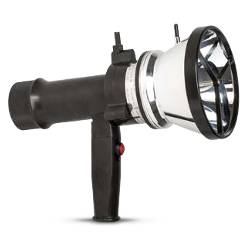Long-Range Flame Simulators
To comply with local standards and jurisdiction, "end-toend" loop testing of Fire Protection Alarm Systems, including detectors, should be performed periodically. Many Safety Authorities and Plant Managers of high value / high risk assets and facilities insist on quarterly "endto-end" testing of their entire Fire Protection Systems using an external Flame Simulator.
List of Benefits
- Ensure optimal performance of detectors
- Compact
- Included in carry case
- Available for hire
Spectrex Flame Simulators are ATEX/IECEx approved for use in Zones 1 & 2, Zones 21 & 22 hazardous areas and are powered by rechargeable Li-Ion batteries. When fully charged, the Fire Simulator will operate for at least 50 tests without recharging.
Most Spectrex optical flame detectors, including UV, UV/IR, single band IR, Triple and Multi band IR types, etc., have automatic integral self-tests (BIT) to check window cleanliness and sensor operation. However, the automatic self-test only partially checks the operational readiness of a detector as the actual alarm outputs are not activated (and rightly so as these tests are performed every 15 minutes).
Using an external, portable Spectrex Flame Simulator is the best means to perform a full functionality, "endto-end" test of the Detector and the Fire Protection System without the need to start a real fire (which is not permitted in hazardous areas and can be dangerous in non-hazardous areas).
The Spectrex Flame Simulator is the only safe method to test the flame detector’s sensors, internal electronics, alarm activation software, cleanliness of the viewing window/lens, wiring integrity, actual relay activation, and proper functionality of any other outputs used (mA, RS485, HART). Also, our Flame Simulator is the only practical method to test the complete Fire Alarm System and ensure that all the system wiring and cabling as well as the system control panel(s) is properly installed.
The external Flame Simulator also verifies that the detector has an unobstructed view of the fire detection area. All optical flame detectors are line-of-sight devices; therefore, they must be properly positioned and angled with an unobstructed view of the intended detection area so that they can "see" in order to detect flames/fires. A physical obstruction in the detector’s partial or full field of view can seriously compromise the integrity of the fire detection ("blind") and protection system.
These ‘obstructions’ include:
- Overspray with paint, vehicles, masking tape, storage boxes and hanging garments, tarpaulins, etc., physically covering the detector’s window viewing lens.
- Detector mounting bracket breakage, failure or misalignment, where the detector is then improperly ‘aimed’ at the correct fire detection area. The detector must be able to "see" the fire. Since most optical flame detectors are used in industrial applications, vibration, physical impact, maintenance, cleaning, etc., can cause improper detector orientation, resulting in an unprotected detection zone even though the detector is reporting a successful automatic self-test to the Fire Alarm Panel. This kind of "false security" could be disastrous if an actual fire occurred in this unprotected area.
- Storage crates, equipment, air ducts or pipes placed or installed after Fire Protection System commissioning that are in the detector’s direct field of view of the detection area. Again, the detector with automatic self-test will report to the Fire Alarm Panel that it is working properly even though it is unable to alarm to a fire occurring in its detection coverage area.
Using an external Flame Simulator verifies a flame detector’s viewing window cleanliness and its internal electronic operation similar to an internal automatic detector self-test. However, importantly, it will also functionally test its critical alarm outputs, whether relay contact activation, 4-20mA alarm output, RS-485 ModBus digital output or HART, the detector and system’s wiring terminals, cabling and its connections, Fire Alarm Panel functionality, proper alarm notification, and, if desired, actual suppression release, etc. (If an actual suppression release is NOT desired, this action must be disabled at the Fire Alarm Release Panel prior to Flame Simulator use.)
| Specification | Detail Description |
|---|---|
| For individual specifications please see brochures available in downloads tab. | |
20170905-Spectrex-Simulator-FS1100-Brochure.pdf 52.2 KB
20170905-Spectrex-Simulator-FS1200-Brochure.pdf 52.42 KB
20170905-Spectrex-Simulator-FS1300-Brochure.pdf 52.31 KB
20170905-Spectrex-Simulator-FS1400-Brochure.pdf 52.33 KB
Approvals
20170405-Spectrex-Flame-Simulators-Approval-IECEx_SIR_15.0041X_1.pdf 137.26 KB

